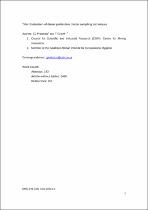JavaScript is disabled for your browser. Some features of this site may not work without it.
- ResearchSpace
- →
- Research Publications/Outputs
- →
- Journal Articles
- →
- View Item
| dc.contributor.author |
Pretorius, CJ

|
|
| dc.contributor.author |
Grove, T

|
|
| dc.date.accessioned | 2012-03-23T15:05:41Z | |
| dc.date.available | 2012-03-23T15:05:41Z | |
| dc.date.issued | 2011-09 | |
| dc.identifier.citation | Pretorius, CJ and Grove, T. 2011. Evaluation of diesel particulate matter sampling techniques. Occupational Health Southern Africa, vol. 17(5), pp 4-13 | en_US |
| dc.identifier.issn | 1024-6274 | |
| dc.identifier.uri | http://www.occhealth.co.za/?/issue/214 | |
| dc.identifier.uri | http://hdl.handle.net/10204/5678 | |
| dc.description | Copyright: 2011 Occupational Health Southern Africa | en_US |
| dc.description.abstract | The study evaluated diesel particulate matter (DPM) sampling methods used in the South African mining industry. The three-piece cassette respirable, open face and stopper sampling methods were compared with the SKC DPM cassette method to find a comparable DPM sampling method for the non-coal mining industry. Controlled surface and underground static (i.e. area) and personal sampling studies were conducted. Triplicate analysis was carried out on each sampled filter using the NIOSH 5040 method to obtain elemental carbon, organic carbon and total carbon values. The results of the three-piece cassette sampling methods compared well with the SKC method and it was concluded that any of the three methods could be used to determine the DPM exposure of mineworkers in terms of the elemental carbon marker. In terms of standardising the DPM sampling methods for non-coal mining industries, the respirable method had certain advantages. | en_US |
| dc.language.iso | en | en_US |
| dc.publisher | Technique Publishing | en_US |
| dc.relation.ispartofseries | Workflow;8428 | |
| dc.subject | Diesel particulate matter | en_US |
| dc.subject | NIOSH 5040 method | en_US |
| dc.subject | SKC cassette | en_US |
| dc.subject | DPM sampling method | en_US |
| dc.subject | South African mining industry | en_US |
| dc.subject | South African mines | en_US |
| dc.subject | Non-coal mining industry | en_US |
| dc.title | Evaluation of diesel particulate matter sampling techniques | en_US |
| dc.type | Article | en_US |
| dc.identifier.apacitation | Pretorius, C., & Grove, T. (2011). Evaluation of diesel particulate matter sampling techniques. http://hdl.handle.net/10204/5678 | en_ZA |
| dc.identifier.chicagocitation | Pretorius, CJ, and T Grove "Evaluation of diesel particulate matter sampling techniques." (2011) http://hdl.handle.net/10204/5678 | en_ZA |
| dc.identifier.vancouvercitation | Pretorius C, Grove T. Evaluation of diesel particulate matter sampling techniques. 2011; http://hdl.handle.net/10204/5678. | en_ZA |
| dc.identifier.ris | TY - Article AU - Pretorius, CJ AU - Grove, T AB - The study evaluated diesel particulate matter (DPM) sampling methods used in the South African mining industry. The three-piece cassette respirable, open face and stopper sampling methods were compared with the SKC DPM cassette method to find a comparable DPM sampling method for the non-coal mining industry. Controlled surface and underground static (i.e. area) and personal sampling studies were conducted. Triplicate analysis was carried out on each sampled filter using the NIOSH 5040 method to obtain elemental carbon, organic carbon and total carbon values. The results of the three-piece cassette sampling methods compared well with the SKC method and it was concluded that any of the three methods could be used to determine the DPM exposure of mineworkers in terms of the elemental carbon marker. In terms of standardising the DPM sampling methods for non-coal mining industries, the respirable method had certain advantages. DA - 2011-09 DB - ResearchSpace DP - CSIR KW - Diesel particulate matter KW - NIOSH 5040 method KW - SKC cassette KW - DPM sampling method KW - South African mining industry KW - South African mines KW - Non-coal mining industry LK - https://researchspace.csir.co.za PY - 2011 SM - 1024-6274 T1 - Evaluation of diesel particulate matter sampling techniques TI - Evaluation of diesel particulate matter sampling techniques UR - http://hdl.handle.net/10204/5678 ER - | en_ZA |







